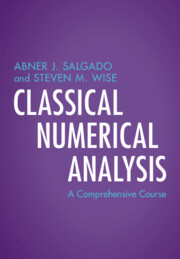Book contents
- Frontmatter
- Contents
- Preface
- Acknowledgements
- Symbols
- Part I Numerical Linear Algebra
- Part II Constructive Approximation Theory
- Part III Nonlinear Equations and Optimization
- Part IV Initial Value Problems for Ordinary Differential Equations
- Part V Boundary and Initial Boundary Value Problems
- 23 Boundary and Initial Boundary Value Problems for Partial Differential Equations
- 24 Finite Difference Methods for Elliptic Problems
- 25 Finite Element Methods for Elliptic Problems
- 26 Spectral and Pseudo-Spectral Methods for Periodic Elliptic Equations
- 27 Collocation Methods for Elliptic Equations
- 28 Finite Difference Methods for Parabolic Problems
- 29 Finite Difference Methods for Hyperbolic Problems
- Appendix A Linear Algebra Review
- Appendix B Basic Analysis Review
- Appendix C Banach Fixed Point Theorem
- Appendix D A (Petting) Zoo of Function Spaces
- References
- Index
29 - Finite Difference Methods for Hyperbolic Problems
from Part V - Boundary and Initial Boundary Value Problems
Published online by Cambridge University Press: 29 September 2022
- Frontmatter
- Contents
- Preface
- Acknowledgements
- Symbols
- Part I Numerical Linear Algebra
- Part II Constructive Approximation Theory
- Part III Nonlinear Equations and Optimization
- Part IV Initial Value Problems for Ordinary Differential Equations
- Part V Boundary and Initial Boundary Value Problems
- 23 Boundary and Initial Boundary Value Problems for Partial Differential Equations
- 24 Finite Difference Methods for Elliptic Problems
- 25 Finite Element Methods for Elliptic Problems
- 26 Spectral and Pseudo-Spectral Methods for Periodic Elliptic Equations
- 27 Collocation Methods for Elliptic Equations
- 28 Finite Difference Methods for Parabolic Problems
- 29 Finite Difference Methods for Hyperbolic Problems
- Appendix A Linear Algebra Review
- Appendix B Basic Analysis Review
- Appendix C Banach Fixed Point Theorem
- Appendix D A (Petting) Zoo of Function Spaces
- References
- Index
Summary
We present finite difference schemes for hyperbolic problems. We begin with the transport equation and show the necessity of a certain type of upwinding and/or numerical diffusion for stability. This is illustrated by analyzing all the classical schemes: upwind, downwind, centered, Lax–Friedrichs, Lax–Wendroff. Beam–Warming, and Crank–Nicolson. We then focus on the topic of positivity and max-norm dissipativity of finite difference schemes. We present and sketch the proof of Godunov’s theorem. A brief discussion of dispersion relations is then carried out. Next, we study schemes for the wave equation, and show how to properly choose the discrete initial velocity to attain the desired consistency. To show stability we employ energy and negative norm arguments. The last section is dedicated to developing schemes for symmetric hyperbolic systems. The most well-known finite difference schemes are presented, and their matrix valued symbols are introduced. The symbol is then used to develop the von Neumann stability analysis for this case.
Keywords
Information
- Type
- Chapter
- Information
- Classical Numerical AnalysisA Comprehensive Course, pp. 811 - 836Publisher: Cambridge University PressPrint publication year: 2022
